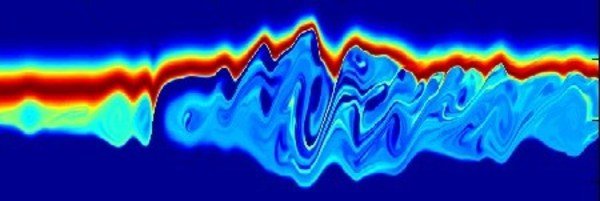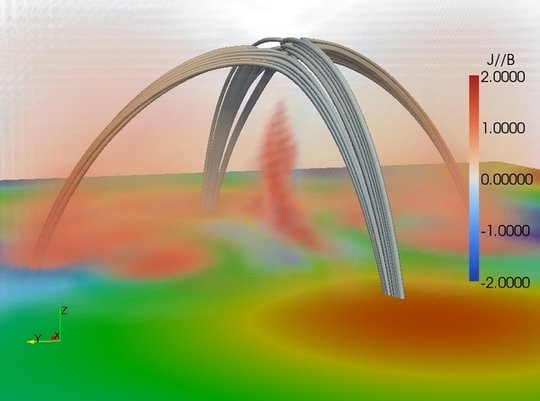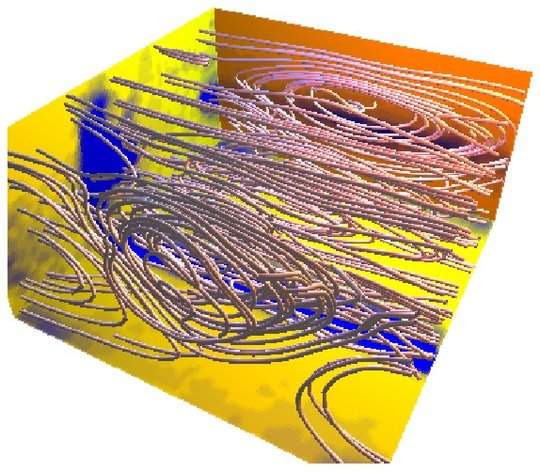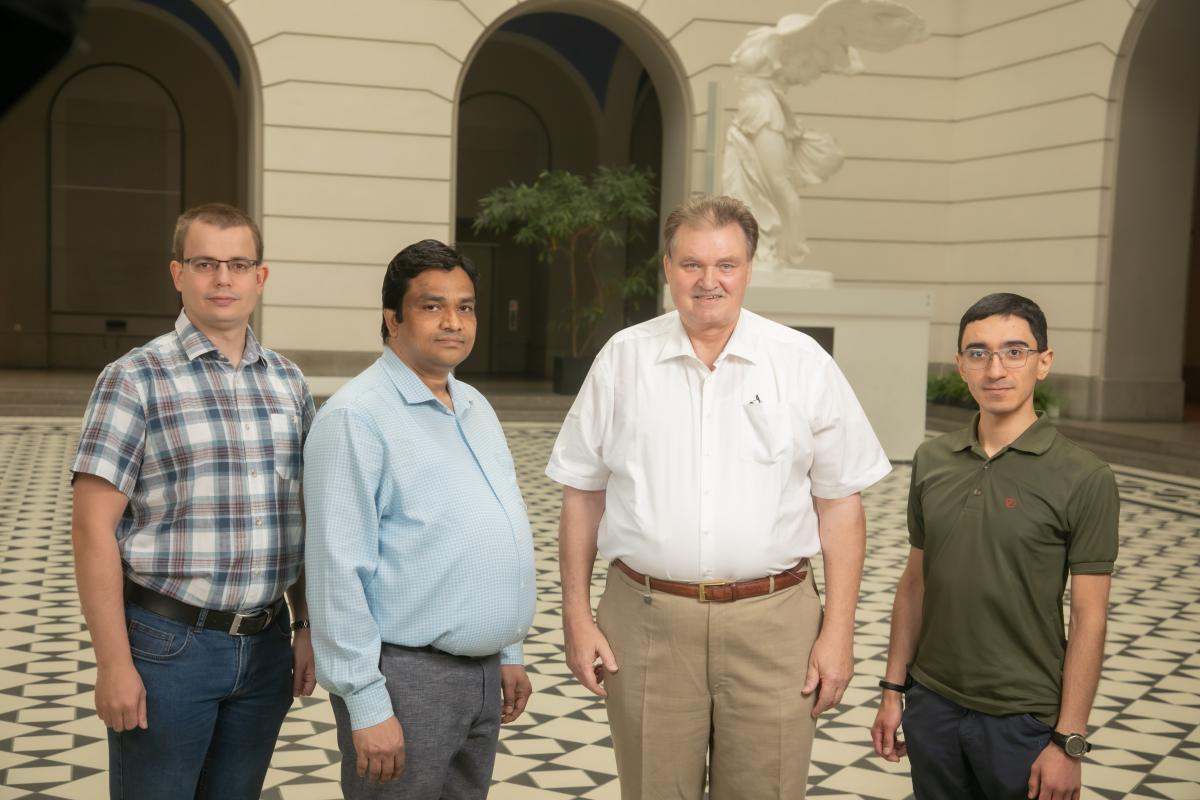SMART: Simulation and Modeling of Astrophysical Reconnection and Turbulence
News: Info about our current summer semester 2023 lecture "Hot Solar System Plasmas"
Contents of this page:

- Figure 1 Turbulent decay of an electron beam - Vlasov code simulation result
- © Büchner and Elkina, 2005
The SMART group investigates the explosive energy release in the Universe by magnetic reconnection and turbulence, their consequences for cosmic structure formation, plasma heating and particle acceleration to high energies. Examples are stellar and solar eruptions, solar flares, coronal mass ejections magnetic storms at the Sun and in planetary magnetospheres, space weather phenomena, the heating of the solar and other stellar coronae, the acceleration of the solar and other stellar winds and explosive magnetic reconnection in laboratory experiments.
For our investigations we use fully kinetic as well as hybrid and fluid plasma models and numerical simulations. Figure 1 shows an early 1D Vlasov code simulation result of the kinetic plasma turbulence due to the decay of an electron beam which we now investigate by 3D supercomputer codes (see a current project list below). Figure 2 illustrates 3D reconnection structure as they form in the solar atmosphere – simulated by means of our GOEMHD3 magnetofluid code.

- Figure 2 Three-dimensional magnetic reconnection in the solar atmosphere: quadrupolar magnetic fields cause hot spots in the corona (temperature: millions of Kelvin, more than hundred times than at the solar surface).

- © Büchner and Santos, 2008
Figure 3 depicts the simulated reconnecting magnetic field resulting from plasma kinetic numerical simulations of reconnection which we obtained for the first time 20 years ago by means of our kinetic PIC-code GISMO - that time assuming artificial model parameters. More realistic simulations became possible now, using modern supercomputers – see the project list below.

- Figure 3 Three-dimensional magnetic reconnection at kinetic scales.
The figure shows the magnetic field as we obtained it by first plasma kinetic numerical simulations of reconnection in 1998. 
- © Büchner and Kuska, 1998
The theoretical investigations of our group are carried out in close relation with astrophysical and space observations as well as with laboratory experiments. Especially important is the collaboration of the group with laboratory plasma physicists in the framework of the Max-Planck-Princeton Center for Plasma Physics like the MRX and FLARE experiments at Princeton and VINETA.II at Greifswald. These laboratory experiments allow a verification of our reconnection and turbulence theories, our numerical simulations allow their extrapolation to the plasmas of the solar system, stellar and galactic plasma processes like the interaction of extrasolar planets with their stars and the dynamics of the Interstellar Medium (ISM).
Group members:
- Prof. Dr. Jörg Büchner, group leader (buechner
 tu-berlin.de, Homepage)
tu-berlin.de, Homepage) - Dr. Jan Benáček (benacek
 tu-berlin.de, ORCID)
tu-berlin.de, ORCID) - Dr. Neeraj Jain (neeraj.jain
 tu-berlin.de, Homepage)
tu-berlin.de, Homepage) - Dr. Patricio Muñoz (pmunoz
 astro.physik.tu-berlin.de, ORCID)
astro.physik.tu-berlin.de, ORCID)
PhD students:
- Zhaodong Shi (zhaodong.shi
 campus.tu-berlin.de). Project: Heavy ion acceleration by turbulence in the solar corona (2020-)
campus.tu-berlin.de). Project: Heavy ion acceleration by turbulence in the solar corona (2020-) - Xin Yao (xin.yao
 campus.tu-berlin.de). Project: Kinetic simulations of radio emission by electron beams in the solar corona (2018-)
campus.tu-berlin.de). Project: Kinetic simulations of radio emission by electron beams in the solar corona (2018-)
Master Students:
- Amirhassan Chatraee Azizabadi. Project: Identification and characterization of current sheets in kinetic plasma turbulence (2019-2020)
Trainees:
- Alina Manthei. Project: Linear kinetic theory of pulsar radio emission (02-06.2020)

- Group picture - September 2022
External Collaboration:
- Dr. Miroslav Bárta (Ondřejov Observatory of the Czech Academy of Sciences, Czech Republic)
- Prof. Gwangson Choe (Kyung Hee University, Yongin, Korea)
- Prof. Dr. Olaf Grulke (MPI for Plasma Physics, Greifswald, Germany)
- Prof. Michael Hesse (University of Bergen, Norway)
- Prof. Masahiro Hoshino (University of Tokyo, Japan)
- Dr. Satoshi Inoue (University Nagoya, Japan)
- Prof. Dr. Frank Jenko (MPI for Plasma Physics, Garching, Germany)
- Prof. Hantao Ji (Princeton University, U.S.A.)
- Dr. Patrick Kilian (Los Alamos National Laboratory, U.S.A.)
- Prof. Siming Liu (Purple Mountain Observatory, Chinese Academy of Sciences, Nanjing, China)
- Prof. Dr. Uwe Mostchmann (Technical University Braunschweig, Germany)
- Prof. Antonius Otto (University of Fairbanks, Alaska, U.S.A.)
- Prof. Jean Carlo Santos (University Curitiba, Brazil)
- Prof. Felix Spanier (Heidelberg University, Heidelberg, Germany)
- Dr. Shangbin Yang (National Astronomical Observatory, Chinese Academy of Sciences, Beijing, China)
- Prof. Nobumitsu Yokoi (University of Tokyo, Japan)
- Dr. Xiaowei Zhou (Purple Mountain Observatory, Chinese Academy of Sciences, Nanjing, China)
Lectures
- SS 2023: Hot Solar System Plasmas. In-presence lecture. Website. TU ISIS link. TU MOSES link. FU link
- WS 2022/2023: Space and Astrophysical Plasma Simulation. Website. TU ISIS link. TU MOSES link. FU link
- WS 2021/2022: Space and Astrophysical Plasma Simulation. Website. TU ISIS link. TU MOSES link. FU link
- SS 2021: Hot Solar System Plasmas. Website. PDF info. TU ISIS link. TU MOSES link. FU link.
- WS 2020/2021: Space and Astrophysical Plasma Simulation. Website. TU ISIS link. TU MOSES link. FU link
- SS 2020: Hot Solar System Plasmas. ZAA link. TU ISIS link. TU LSF link. FU link. PDF Poster.
- WS 2019/2020: Space and Astrophysical Plasma Simulations Webpage. ZAA link. PDF info. TU LSF link. FU link. Lecture slides.
- SS 2019: Hot Solar System Plasmas. ZAA link. LSF link. Lecture slides.
Master's thesis projects
Projects
- MHD simulations: reconnection in the solar corona
- Test particle simulations of acceleration in reconnection
- Hybrid PIC simulations: laboratory magnetic reconnection and turbulence
- EMHD simulations: electron-scale magnetic reconnection, electron shear flow instabilities
- Fully-kinetic PIC simulations: magnetic reconnection, collisionless shocks, plasma instabilities, kinetic turbulence and plasma radiation
- (not active) Kinetic Vlasov simulations: plasma instabilities and magnetic reconnection
- DFG/GCAR Research project: Understanding modern radioastronomical observations via advanced plasma simulations (2020-)
- DFG Research project: Ion scale current sheet instabilities in kinetic plasma turbulence (2018-)
- DFG/NSFC Sino-German Research Project: Probing electron acceleration by fast kinetic guide-field magnetic reconnection using coherent solar radio emissions (2018-)
- ISSI team: Plasma Heating and Particle Acceleration by Collisionless Magnetic Reconnection (2017-2018)
- HPC project: Kinetic simulations of electron-scale turbulent high-beta and asymmetric collisionless magnetic reconnection (2018-2020)
- HPC project: Kinetic simulations of astrophysical and solar plasma turbulence (2017-2020)
- HPC project: Kinetic instabilities mediating particle acceleration in collisionless 3D magnetic reconnection (2016-2017)
Conferences
- May 6th and 7th, 2020: Zoom program of EGU 2020 session ST1.9: Theory and Simulation of Solar System Plasmas

